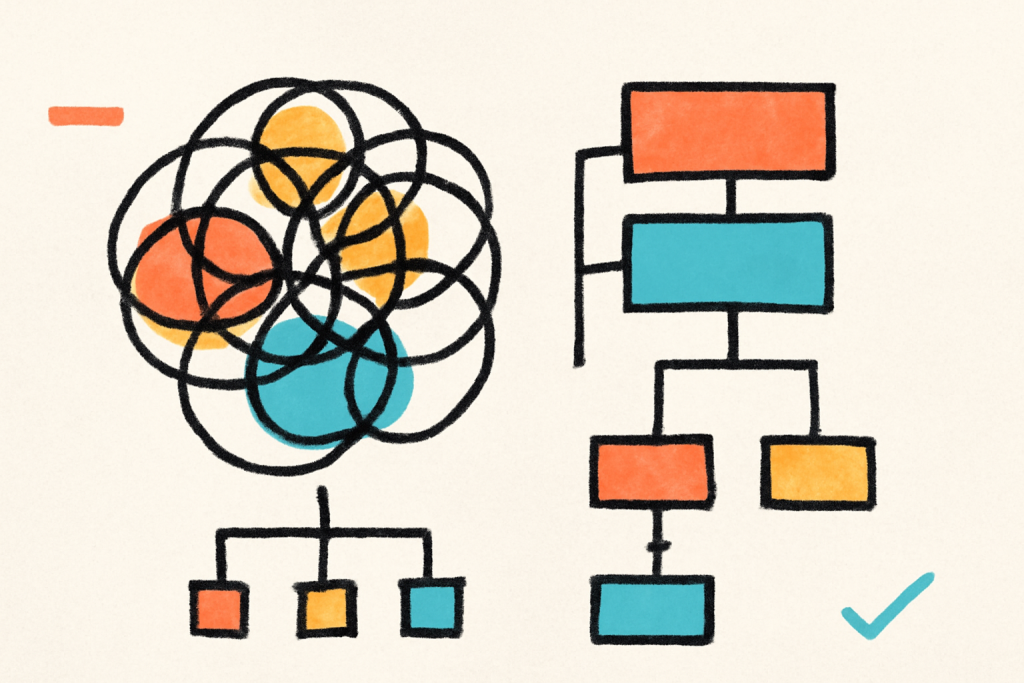Too Many Ideas Require Structure, Not Elimination
Brian Taylor July 28, 2025
In today’s fast-paced world, creativity is often seen as the key to innovation. Yet, many people believe that the abundance of ideas often leads to confusion and inefficiency. In educational and societal settings, the solution isn’t necessarily to discard or eliminate ideas but to give them proper structure. This approach allows individuals and groups to harness the power of diverse thoughts and transform them into tangible, actionable solutions.
As we move forward in the 21st century, fostering creativity within educational frameworks and society at large becomes essential. It is crucial to understand how too many ideas require structure, not elimination to unlock their potential. The concept of structured creativity not only applies to classrooms but is also essential in business, innovation, and problem-solving on a societal scale.
In this article, we will explore why structured thinking leads to more innovative solutions, how educational systems can embrace this concept, and how society can benefit from this mindset.

Why Elimination of Ideas is the Wrong Approach
At first glance, eliminating excess ideas might seem like the simplest way to solve a problem. After all, when facing too many options, the instinct might be to narrow them down quickly. However, this approach often stifles creativity and leaves out valuable perspectives.
The act of eliminating ideas prematurely may result in missed opportunities for innovation. In educational environments, where students are encouraged to think freely, shutting down ideas before fully exploring them can discourage participation and hinder cognitive growth. Studies show that environments fostering open dialogue, without rushing to elimination, allow more room for lateral thinking and creative problem-solving.
The Problem with Traditional Approaches
- Quick Judgments Lead to Limited Thinking: Eliminating ideas too early can close the door on unique solutions that may emerge after further exploration.
- Stifled Collaboration: A focus on elimination can discourage team collaboration, with individuals feeling hesitant to share unconventional or unconventional ideas.
- Creativity Block: The pressure to narrow down ideas immediately can lead to creative blockages and a lack of innovation.
In educational settings, this often manifests as teachers or leaders encouraging quick decisions, leaving no room for trial and error. It reduces opportunities for deeper critical thinking and problem-solving, ultimately hindering student growth.
How Structure Fosters Creativity
While an overload of ideas can feel overwhelming, applying structure can transform this chaos into clear action. Structuring ideas enables individuals and groups to explore various perspectives, connect disparate thoughts, and identify patterns. Structured brainstorming, mind mapping, and organized frameworks help transform raw creativity into valuable concepts.
The Benefits of Structure in Idea Generation
- Clarifies Focus: Structure helps prioritize ideas, giving them clear goals and direction. This allows individuals to see the potential in every idea without feeling the pressure of discarding them too early.
- Encourages Exploration: Rather than eliminating ideas, structure allows for a deeper exploration of each one. As individuals break down complex ideas into smaller, manageable components, the potential for creative solutions increases.
- Enhances Problem-Solving: By organizing ideas, individuals can look for patterns and connections between concepts that would otherwise be missed. Structured thinking fosters the kind of problem-solving necessary in complex real-world situations.
- Improves Collaboration: A structured framework allows multiple viewpoints to come together, encouraging collaboration. With clear objectives and boundaries, individuals can contribute freely while still moving toward a common goal.
The Role of Structured Thinking in Education
Structured thinking is a fundamental part of an effective educational system. The education system should encourage students not just to have ideas, but also to know how to refine, develop, and apply them. Structured thinking tools like design thinking, critical thinking frameworks, and collaborative problem-solving can help students take their ideas from inception to application.
How to Foster Structured Thinking in Education
- Mind Mapping and Concept Mapping: These visual tools help students organize ideas and show relationships between different concepts. By seeing how their thoughts connect, students can better understand the bigger picture and generate deeper insights.
- Design Thinking: This human-centered approach to problem-solving encourages students to empathize, define, ideate, prototype, and test. By structuring the problem-solving process, students learn how to refine their ideas and identify feasible solutions.
- Collaborative Brainstorming: When working in groups, students can use structured brainstorming techniques to share and organize their ideas. This ensures every voice is heard while maintaining focus and direction.
A Case Study: Design Thinking in Education
Design thinking, originally a tool for innovation in business, has found a place in the classroom. In a study published by the Journal of Educational Psychology, educators observed that when students applied design thinking to class projects, their ability to generate creative ideas improved significantly. The structured nature of design thinking provided students with a process that guided them from initial ideas to refined, workable solutions.
Students in these classrooms did not discard ideas—they iterated on them, adjusted them, and built upon them. This approach enabled them to approach problems in more creative ways, without fear of rejection or elimination of their thoughts.
Structured Thinking and Society: Why It Matters
In society, the concept of structured thinking has an even broader impact. Communities and organizations benefit from organized collective thought, especially when tackling societal issues such as climate change, inequality, and healthcare reform. These are complex problems that require contributions from many diverse minds, but without structure, these ideas can become disjointed and ineffective.
By applying structured thinking at a societal level, we can ensure that ideas are not only heard but also organized, prioritized, and acted upon. Government initiatives, public policy, and social movements are all driven by ideas, but their success depends on how well these ideas are structured and implemented.
Examples of Structured Thinking in Society
- Public Policy Development: Effective public policy requires careful planning and structured dialogue between experts, stakeholders, and citizens. By organizing the vast array of opinions, policymakers can create policies that reflect a wide variety of perspectives while remaining focused on actionable solutions.
- Social Movements: Successful movements such as those advocating for racial equality or climate change action rely on organized frameworks to maintain focus. These movements thrive when ideas are structured into clear goals, messaging, and actions that unite people for a common cause.
Collaboration and Collective Action
Collaboration is essential for societal progress, and when structured thinking is used in this context, it facilitates more effective teamwork. Community initiatives and societal reforms are more likely to succeed when individuals and organizations work together within a clear framework.
How to Apply Structure to Your Ideas
If you’re finding that your own ideas are piling up without a clear direction, here’s how you can begin to structure them:
- Start with a Mind Map: Visualize your ideas and break them down into categories. This will help you see the connections between concepts and refine your thoughts.
- Use the 5 W’s: For every idea, ask yourself Who, What, When, Where, and Why. This simple exercise helps you examine the practicality and impact of your idea.
- Prioritize Ideas Based on Impact and Feasibility: Once you have a list of ideas, evaluate them based on their potential impact and feasibility. Structure your action plan by focusing on the ideas that have the highest potential to succeed.
- Iterate, Don’t Eliminate: Remember, elimination isn’t always the answer. Instead of discarding ideas, see how they can evolve. Tweak, modify, and iterate on them as you go along.
Conclusion
In education and society, ideas need structure to flourish. Rather than dismissing or eliminating ideas, we should seek to organize and refine them, which leads to more impactful solutions. By encouraging structured thinking in educational environments and society at large, we can foster creativity, collaboration, and innovative problem-solving. As we move into a future filled with complex challenges, the ability to generate and organize ideas effectively will be one of the most valuable skills for success.
References
- Journal of Educational Psychology (2020). “Design Thinking in the Classroom: Enhancing Student Creativity.” Available at: https://www.apa.org
- Harvard Business Review (2021). “The Role of Structure in Creative Problem-Solving.” Available at: https://hbr.org
- Edutopia (2020). “Fostering Creativity with Structured Learning Techniques.” Available at: https://www.edutopia.org





